Scotland National Strategy for Economic Transformation: evidence paper
This Evidence Paper presents evidence on the structure and performance of Scotland’s economy, and identifies areas where the new National Strategy for Economic Transformation must take action to deliver transformational improvements to Scotland’s economic performance.
2. Scotland Economic Performance
2.1 Macroeconomic performance
Scotland is a small open economy with a population of 5.4 million and on-shore GDP of circa £160 billion (excluding oil), which accounts for around 8.0% of UK economy. It accounts for about a third of UK landmass, and possesses key natural resources across its land and seas. As part of the UK economy, Scotland's economy has faced a number of challenges in recent years. These include the impacts of the 2008-09 financial crisis; UK government austerity measures; the oil price shock from 2014 and early adjustment in anticipation of the UK leaving the European single market.
Currently, the most common indicator for measuring economic activity is Gross Domestic Product (GDP), which is the total monetary value of all the goods and services produced in a country over a period. Economic growth in Scotland, measured in terms of the change in GDP over time, has been relatively subdued since the 2008-09 financial crisis. The average GDP growth rate over the period 2000 to 2019 was 1.4%. Over the period 2000–2007 it was 2.4% and fell to 0.7% over the period 2008-2019.
However, GDP does not capture broader wellbeing, environmental factors or the level of equality in a society. It also does not capture the value of all activity in the economy, such as volunteering or unpaid caring and household work. It does not take account of the impact current activity has on future generations, for example on our environment and nature. For these reasons, this report also looks at a wider range of indicators for economic performance and prosperity. There is a commitment in the NSET to develop a broader set of Wellbeing Economy indicators for Scotland.
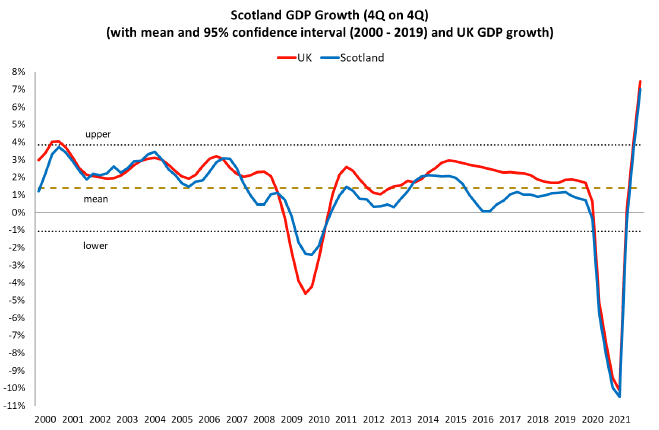
Source: Scottish Government
Note: includes mean and 95% confidence interval (2000-2019) and UK GDP growth
The COVID-19 pandemic and necessary restrictions on the economy to protect public health have had a significant impact on GDP since 2020. Following the first COVID-19 lockdown in March 2020, Scotland's economy contracted by 23% relative to the period before the measures were introduced. The economy has been recovering from the impacts of the lockdown on a monthly basis, and returned to pre-pandemic levels of output for the first time in November 2021.
The Scottish Fiscal Commission forecast (December 2021) that Scotland's economy will grow by 3.8% in 2022. They also suggest that longer term scarring to the economy from Covid will mean that trend GDP at the start of 2025 is forecast to remain 2% lower than their pre-pandemic forecast. However, this is less than previously expected at the start of 2021.
Despite the challenges presented above and evidence of subdued performance, Scotland's economy still compares strongly internationally. In 2019, Scotland's GDP per head (including offshore) was $48,373 at Purchasing Power Parity and ranks in the 2nd quartile of Organisation for Economic Co-operation and Development (OECD) country rankings.
Figure 2.1.2 - GDP per Head in OECD Countries, 2019
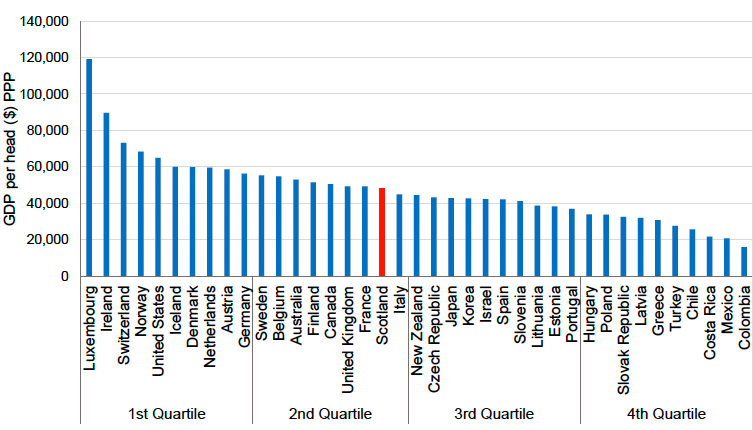
Source: OECD, Scottish Government
2.2 Productivity
Productivity, generally measured as output per unit of labour, is probably the most important measure of economic performance and competitiveness. Productivity growth has slowed across most developed nations, and has particularly struggled to recover since the global financial crisis. Along with other developed nations, Scotland's real terms productivity has been almost stagnant since 2008-09, in common with trends in the rest of the UK and other advanced economies. Productivity levels in 2018 could have been 30-percentage points higher if pre-financial crisis growth rates had continued.
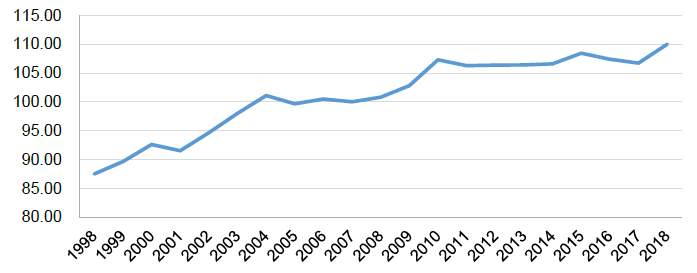
Source: Scottish Government
The National Performance Framework tracks Scotland's productivity performance against OECD countries, with the target to reach the top quartile. Scotland's productivity ranking has remained 16 out 37 in the last six years to 2018, and it has not shifted significantly in the last couple of decades.
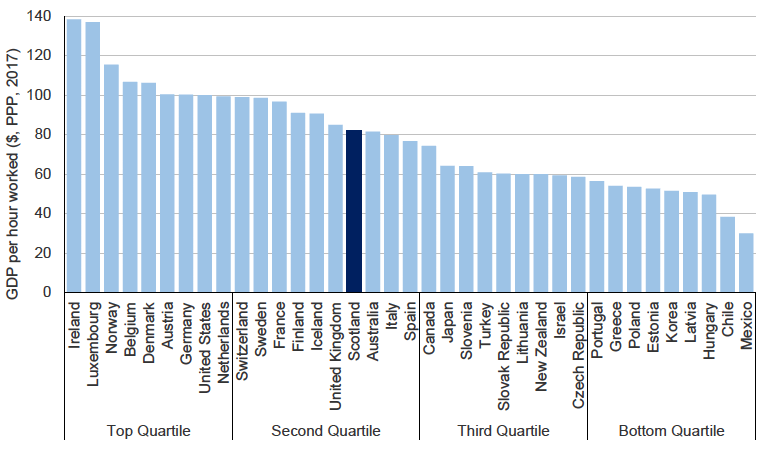
Source: Scottish Government
Scotland's productivity performance varies significantly across sectors and businesses of different sizes, in terms of both levels and trends. While productivity growth has been subdued across the whole economy since 2008-09, the manufacturing sector has performed relatively well when compared to non-manufacturing production (agriculture, forestry, fishing and mining), construction and services.
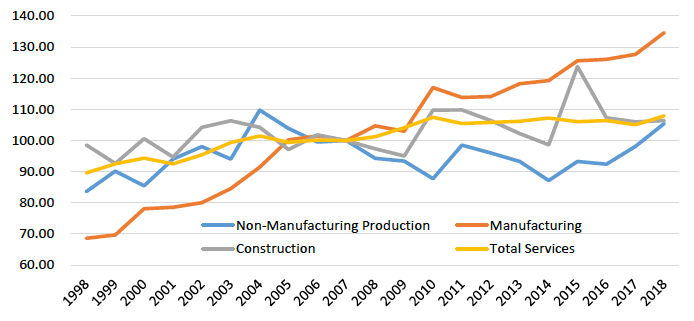
Source: Scottish Government
On productivity levels, non-manufacturing production and manufacturing lead the broad industry groups, while construction lags behind. However, there will be significant differences in productivity performance within individual sectors and sub-sectors making up the broad industry groups (See Section 3.1 for detailed sectoral breakdowns in productivity).
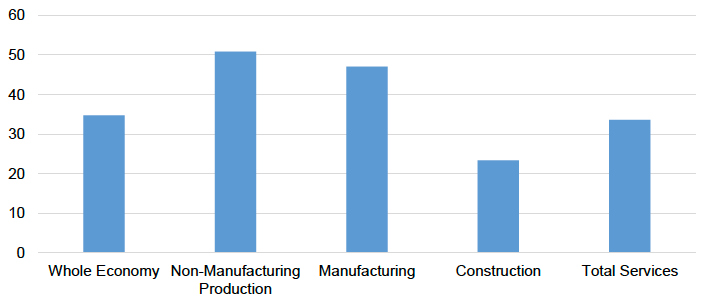
Source: Scottish Annual Business Statistics
2.3 Structure of Scotland's Economy
The structure of Scotland's economy has changed gradually over the last seven decades. The contribution of the 'Government and Other' and the 'Business Services and Finance' industry sectors to the economy have grown in relative importance, while the relative contribution of 'Manufacturing' and 'Non-Manufacturing Production' has declined.
The changing structure of the economy, especially the shift away from the high productivity manufacturing and non-manufacturing production would have affected Scotland's overall economic growth performance. However, such structural changes in the economy are characteristics of the development path of many economies over time.
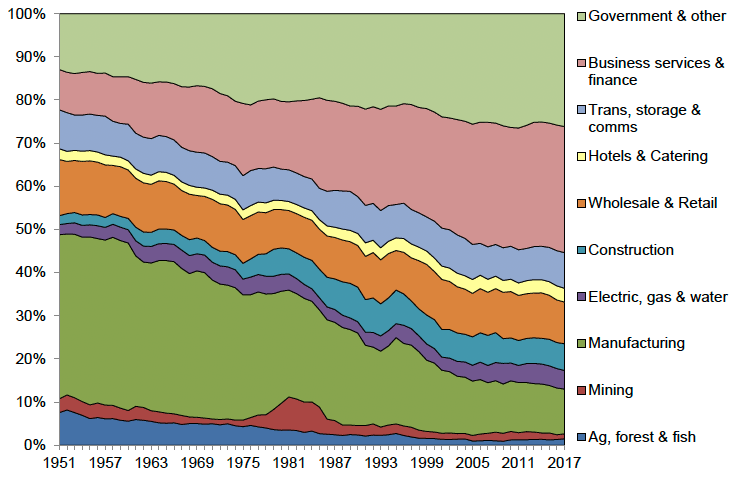
Source: Experimental Scottish National Accounts and Scottish Government Input-Output tables.
Note: these data are not fully consistent over time because of changes in accounting systems and industrial classifications.
Overall, Scotland's economy remains diverse with a wide range of sectors contributing to output, employment and exports. Figure 2.3.2 shows the contributions of different economic sub-sectors to Scotland's GVA.
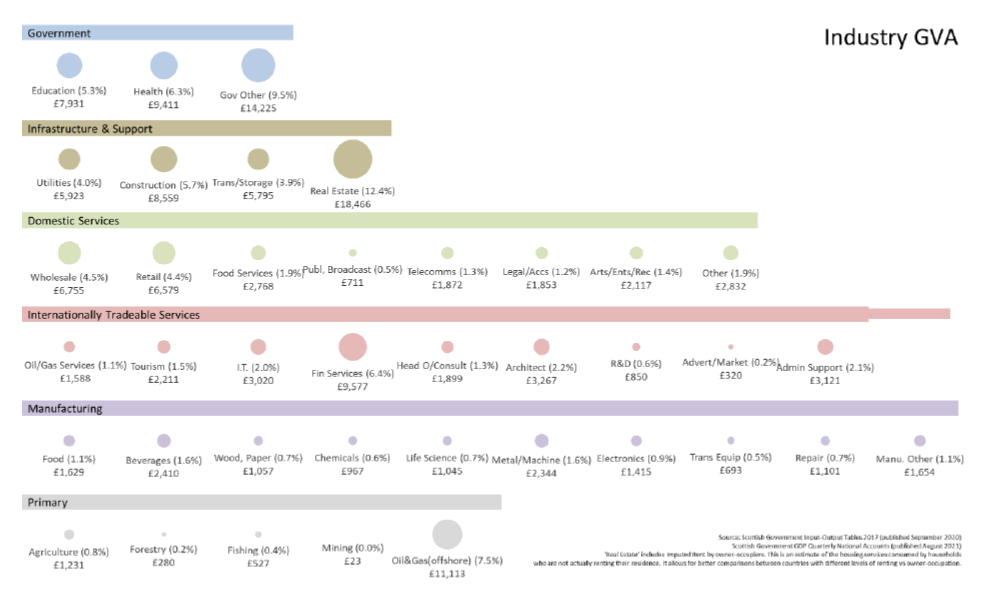
2.4 Employment
Scotland's labour market participation has performed well since the 2008-09 financial crisis, with headline labour market indicators – employment and unemployment – close to their record levels. Scotland's employment rate recovered gradually from 69.8% in February to April 2010 to 75.4% just before the COVID-19 pandemic (December to February 2020). The growth in the employment rate has reduced the unemployment rate, while the economic inactivity rate has remained broadly unchanged over this period
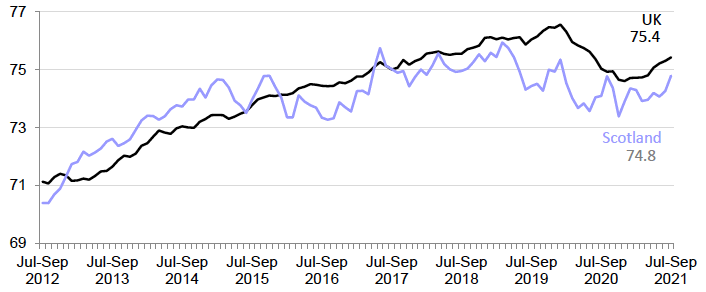
Source: Labour Force Survey, Seasonally adjusted, ONS
Despite the COVID-19 pandemic being an acute negative shock on the economy, Scotland's employment rate has been resilient because of employment support offered to businesses through the furlough schemes (the Coronavirus Job Retention Scheme and the Self Employment Support Scheme). In fact, at the time of writing, a number of Scotland's economic sectors were facing significant labour and skills shortages (see Section 3 for detailed discussion).
While managing economic recovery from COVID-19 will be critical in the short and medium-term, particularly mitigating 'scarring' effects that could have long term damaging impacts on the workforce affected; another key challenge is how to improve employment outcomes for equalities groups: young people (16-24 years); minority ethnic populations; women and disabled people. There remain significant employment gaps for these groups, and in some instances, the employment gaps have worsened.
Box 2.1. Scotland's Labour Market and Equalities Groups
Substantial gaps remain in the employment rate for equalities groups. For example, the employment rate for young people (16-24 years) was 51.8 per cent,[3] significantly lower than for the population (16-64 years) - 72.2 per cent. However, around 46.3 per cent of young people are in full-time education.
While the employment rate for men was74.4 per cent, the employment rate for women was lower at 70.1 per cent, an employment rate gap of 4.3 percentage points.
The disability employment gap in Scotland[4] has reduced in recent years but remains high at 32.0 percentage points.
The employment rate gap for the minority ethnic[5] population compared with the white population was 9.7 percentage points, and the gap was substantially higher for women (16.6 percentage points) compared with men (1.2 percentage points).
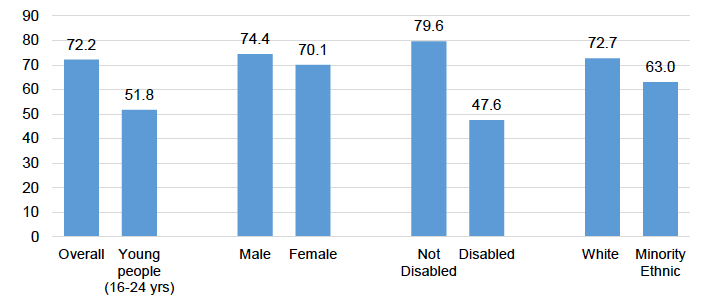
Source: Annual Population Survey July 2020 to June 2021, ONS
Note: All employment rates refer to the population 16-64 years, unless otherwise stated
Figure 2.4.3 shows the distribution of employment across different sub-sectors of Scotland's economy. It shows differences across sectors, which is mostly due to variations in labour intensities in production.
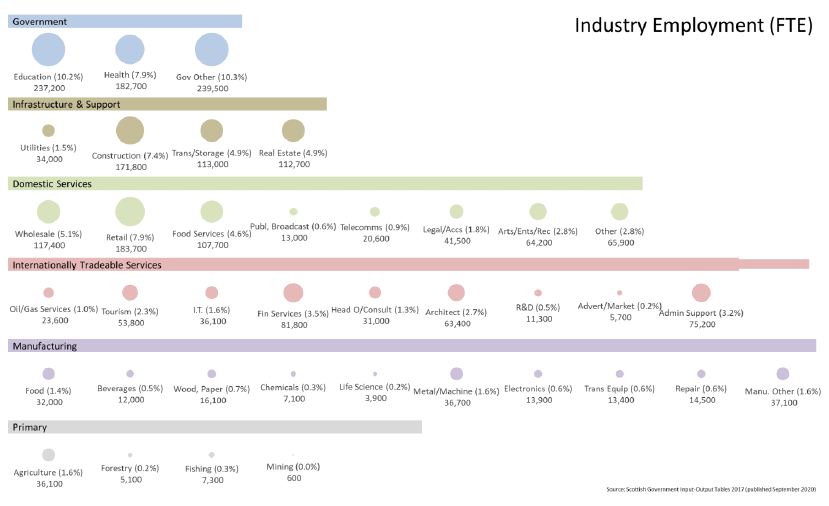
2.5 Earnings from Employment
Scotland's real gross median weekly pay for full-time employees has barely increased since the 2008-09 financial crisis. Scotland's real gross median weekly pay for full-time employees has only exceed its historic peak (2010) for the first time in 2020. The slow growth in productivity over the last decade, along with economic shocks from the financial crisis and more recently the pandemic, partly explains the trend in real pay.
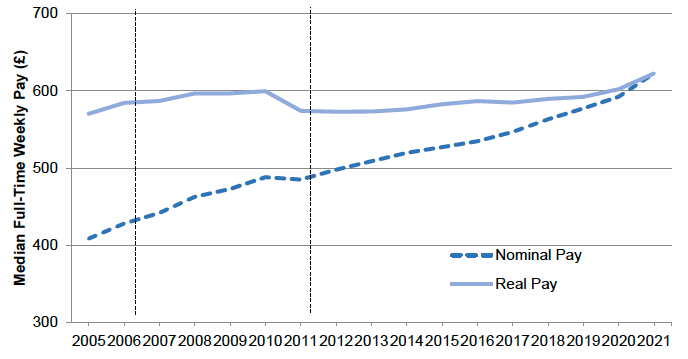
Source: Annual Survey of Hours and Earnings 2021, ONS
Note: Real Pay Adjusted for inflation (using the Consumer Price Index including owner-occupier housing costs (CPIH)
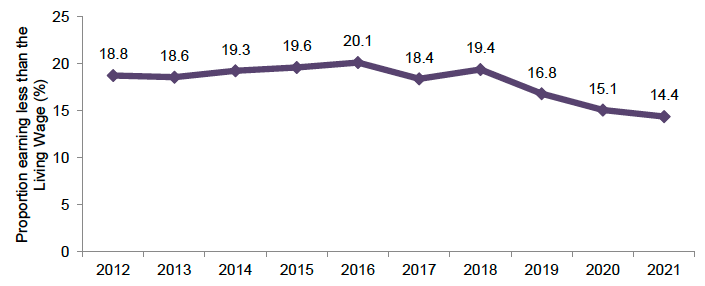
Source: Annual Survey of Hours and Earnings 2021, ONS
The Scottish Government's aspires for every working adult (18 years and above) in Scotland to earn at least the Real Living Wage[6] (£9.50 in Scotland in 2021). In 2021, 14.4% of all employees aged 18 years and over (about 333,000 employees) earned below the 'Real Living Wage'. The proportion of employees earning less than the Real Living Wage remained relatively constant between 2012 and 2016, ranging between 18.6% and 20.1%. Since 2018, it has decreased consistently (see Section 3.2 for detailed evidence on sectoral performance against the Real Living Wage).
2.6 Regional economic performance
When comparing the value of economic activity across Scotland's regions as measured by gross value added (GVA) per capita, there are significant differences in economic performance. At the Regional Economic Partnership area level, the 'Aberdeen City Region' and 'Edinburgh and South East Scotland City Region' perform relatively well, while the 'Ayrshires' and 'South of Scotland' regions lag behind. In 2018, the Ayrshires GVA per capita was less than half that of the 'Edinburgh and South East Scotland City Region' and the 'Aberdeen City region'.
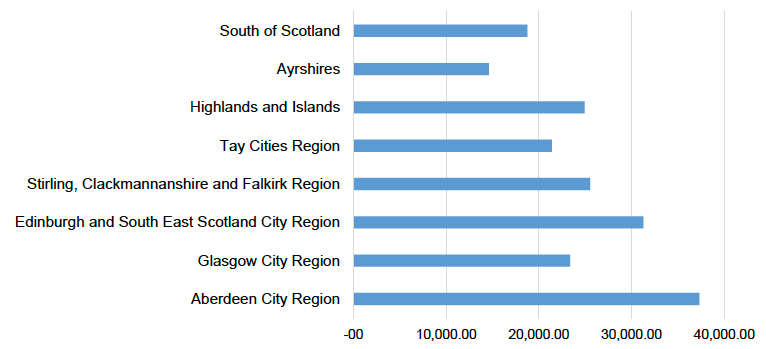
Source: Scottish Annual Business Statistics
The proportion of workless households (where no adult is working) across Scottish local authorities follows a similar pattern to economic performance and other inclusion/socio-economic indicators, with post-industrial areas generally lagging behind. A range of other wellbeing economy indicators including quality of jobs or public services, the health of citizens, index of multiple deprivation and child poverty reveal similar regional differentials (see Box A in the NSET Report). Despite efforts to tackle these differentials, significant regional inequalities remain.
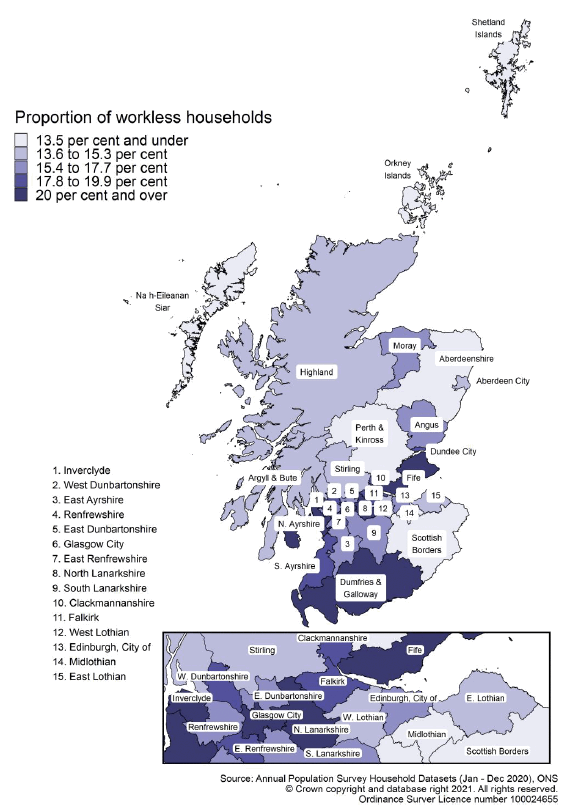
Source: Annual Population Survey (Household Data set) 2020
Note: Workless households Number of households where no adults are in employment and containing at least one person aged 16-64 years
2.7 Scotland's business base
There were 364,310 registered and unregistered businesses operating in Scotland in 2020. This is an increase of 22% from 2010. Between March 2020 and March 2021, however, the estimated number of businesses decreased by 5.4% (-19,805 businesses), in line with trends across the whole UK and reflecting the impact of the COVID-19 pandemic on the economy.
Scotland's business base is diverse. However, construction and professional, scientific and technical services account for the largest shares, mainly reflecting the prevalence of micro and small enterprises in these sectors.
Other sectors like mining and quarrying (including oil and gas businesses) have much fewer businesses, although they tend to have a very high concentration of Scotland's jobs in large businesses.
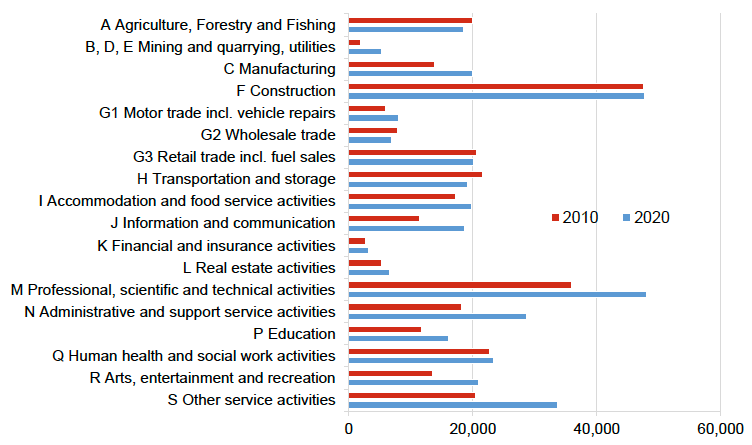
Source: Scottish Government
The vast majority (93.6% - equivalent to 341,030) of businesses in Scotland are micro businesses (employing fewer than 10 people), averaging around 2.5 employees per business. Micro businesses accounted for 28.4% of private sector employment and 16.6% of private sector turnover in Scotland in 2020. At the other end, Scotland's 2,435 large businesses (with 250 or more employees) accounted for 44.3% of all jobs in Scotland and 58.8% of turnover.
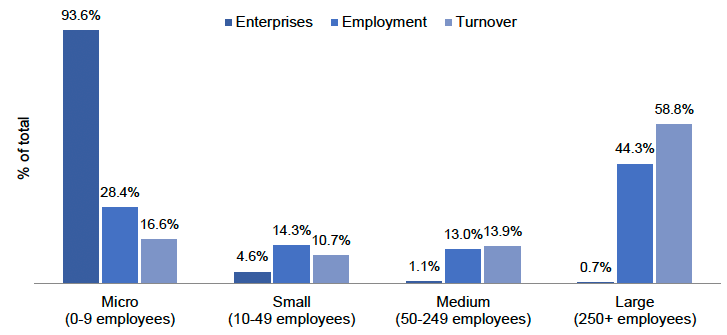
Source: Scottish Government
The growth in the business base over the last decade has largely been driven by an increase in the number of micro businesses, which have seen a 22.7% increase (63,105 businesses between 2010 and 2020) compared to a 7.7% increase in the number of large businesses (175 businesses). Over the same period, the share of total jobs in micro businesses increased from 26.3% to 28.4%, whereas the share of jobs in large businesses fell from 47.1% in 2010 to 44.3% in 2020. When compared to the UK as a whole, Scotland still has a relatively high share of jobs in large businesses (44% in Scotland compared to 39% in the UK).
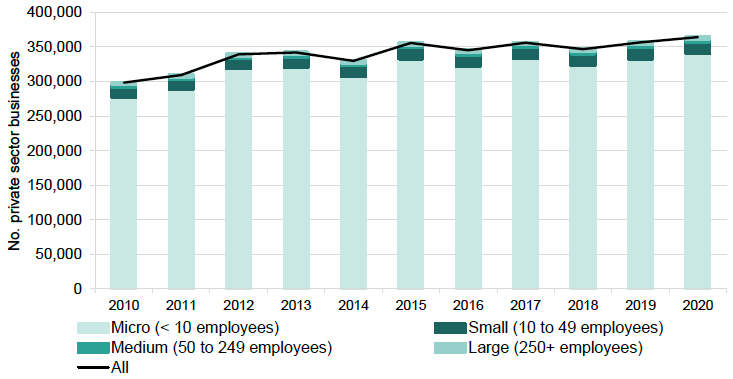
Source: Scottish Government
In 2020, there were 179,460 VAT/PAYE registered private businesses in Scotland, about half of the total businesses (registered and unregistered). By broad economy grouping the largest share of Scotland's registered businesses is in the 'domestic services' sectors, followed by 'internationally traded' and then 'infrastructure and support' sectors (see Figure 2.4.3 for definition).
The 'internationally traded services' and 'infrastructure and support' industries have largely driven growth in Scotland's registered businesses over the period 2010 to 2020. The numbers have not changed significantly for the other broad sector groupings.
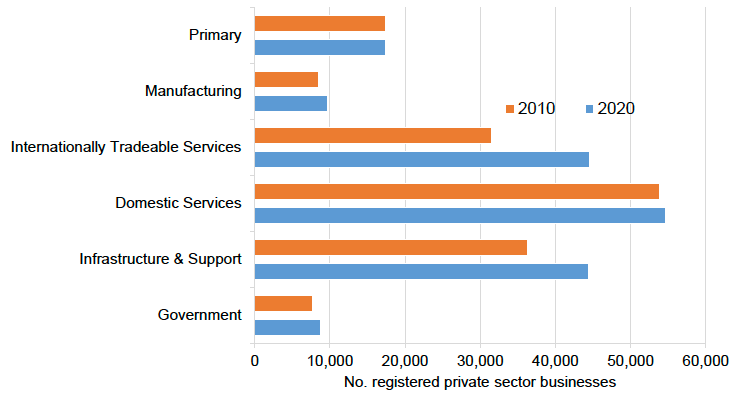
Source: Scottish Government
2.8 What the evidence tells us we need to address
The evidence presented in this Section shows that Scotland's economy has faced a number of challenges in recent years that the NSET needs to address. These include:
- subdued economic growth since the 2008-09 financial crisis and the application of UK wide austerity. The impacts of the COVID-19 pandemic could exacerbate this. While Scotland's economic growth performance has improved over the medium term, it has worsened when compared with other OECD countries;
- low to almost stagnant productivity growth in the last decade, with GDP growth mostly driven by increased employment. Productivity growth was concentrated in higher productivity sectors (manufacturing and internationally tradable services);
- restructuring of the economy towards low productivity sectors, which has impacted on Scotland's overall economic performance. To shift the dial on productivity across the whole economy we also need to increase performance in the traditionally lower productivity services sectors.
- low growth of earning from employment, with a significant although reducing proportion of the workforce earning below the real living wage;
- deep seated regional inequalities in economic performance and their wider implications on the distribution of socioeconomic outcomes and wellbeing across communities;
- Scotland's business base has been growing, but largely from an increase in the number of micro enterprises, including many self-employed workers.
- of the registered businesses in Scotland (~50% of the total), growth has been strongest in 'internationally tradable services' and 'infrastructure and support' sectors, although the domestic services industry still accounts for the largest share of registered businesses.
Section 3 analyses these challenges further to identify their root causes and to shape projects for transformation in the NSET, which are summarised at the end of each sub-section.
Contact
Email: Cornilius.Chikwama@gov.scot
There is a problem
Thanks for your feedback